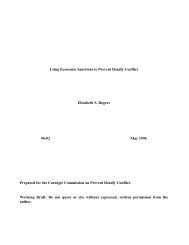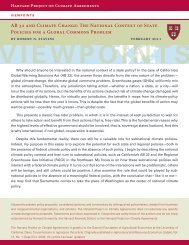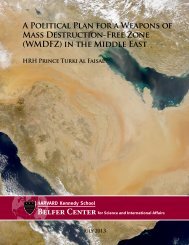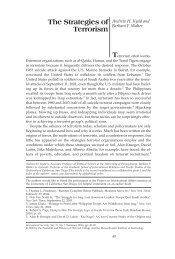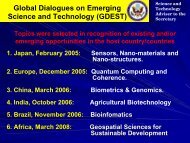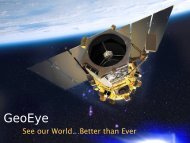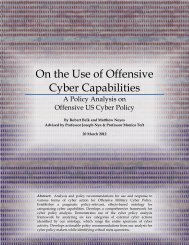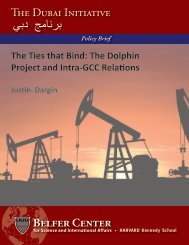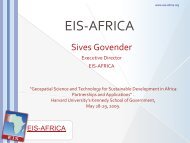Plutonium Mountain - Belfer Center for Science and International ...
Plutonium Mountain - Belfer Center for Science and International ...
Plutonium Mountain - Belfer Center for Science and International ...
- No tags were found...
Create successful ePaper yourself
Turn your PDF publications into a flip-book with our unique Google optimized e-Paper software.
<strong>and</strong> later <strong>for</strong> post-graduate work. Hecker saw himself as a scientist, fulfilling his patriotic duty<br />
<strong>for</strong> his adopted country. He was never a weapons designer. 21<br />
In 1988, Hecker, then the Los Alamos director, <strong>and</strong> other U.S. scientists carried out a joint nuclear<br />
weapons verification experiment with Soviet scientists, a result of the Reagan-Gorbachev 1986<br />
Reykjavik summit, <strong>and</strong> an important early bridge across the Cold War chasm of mistrust. Then,<br />
in February, 1992, just after the Soviet collapse, Hecker made a ground-breaking visit to Arzamas-16,<br />
which had been established as the first Soviet nuclear-weapons laboratory. These were<br />
the breathtaking days of a sudden openness between old adversaries, <strong>and</strong> Hecker used it to build<br />
trust with the Russian scientists. At Arzamas, on the tarmac upon his arrival, he met Yuli Khariton,<br />
who had designed the first Soviet atomic bomb under Igor Kurchatov, <strong>and</strong> who later became<br />
the first scientific director of Arzamas-16. Khariton extended his h<strong>and</strong> <strong>and</strong> said, “I’ve been waiting<br />
<strong>for</strong>ty years <strong>for</strong> this.” With the Soviet Union gone, the Russian scientists were suffering economically,<br />
but they told Hecker they saw themselves as equals of the Americans <strong>and</strong> only wanted<br />
to take part in scientific cooperation on that basis. Hecker established a vital line of communication<br />
to the Soviet weaponeers, a lab-to-lab program of joint projects that helped to overcome<br />
Cold War mistrust. 22 Other ef<strong>for</strong>ts later provided millions of dollars to Russia to assist in helping<br />
secure nuclear materials <strong>and</strong> find ways <strong>for</strong> weapons scientists to shift to civilian projects.<br />
On November 3, 1997, Hecker completed his term as director <strong>and</strong> became a senior fellow at<br />
Los Alamos. He decided at the time to continue his work securing nuclear materials around the<br />
world. He knew plutonium <strong>and</strong> highly-enriched uranium—how they were made <strong>and</strong> why. But<br />
with the Cold War now over, he hoped to use his knowledge to improve global nuclear security<br />
<strong>and</strong> prevent fissile material from falling into the wrong h<strong>and</strong>s.<br />
Hecker knew that security at Russian nuclear installations at the time was often woeful. He <strong>and</strong><br />
others had led a lab-to-lab ef<strong>for</strong>t to secure <strong>and</strong> account <strong>for</strong> nuclear materials, ultimately convincing<br />
the U.S. Department of Energy <strong>and</strong> Russia’s Minatom to launch a broad program called<br />
Materials Control, Protection <strong>and</strong> Accounting, or MPC&A, to deal with the problem. But he was<br />
concerned that despite plans <strong>for</strong> security upgrades at the known sites, there might be material that<br />
remained completely off the radar—overlooked or <strong>for</strong>gotten, <strong>and</strong> there<strong>for</strong>e a greater risk.<br />
Kazakhstan was known to be riddled with nuclear materials from the Cold War. In 1994, the<br />
United States airlifted out of Kazakhstan about 604 kilograms (1,332 pounds) of highly-enriched<br />
uranium left behind by the Soviet Union in an elaborate operation known as Project Sapphire,<br />
one of the most important <strong>and</strong> dramatic attempts to secure these materials.<br />
The early 1990s were focused primarily on removing nuclear weapons <strong>and</strong> delivery vehicles<br />
from the three <strong>for</strong>mer Soviet republics outside of Russia where they were located: Kazakhstan,<br />
Ukraine, <strong>and</strong> Belarus. Among them, Kazakhstan had been most eager to denuclearize. The<br />
country’s strongman leader, Nursultan Nazarbayev, who had been a member of the last Soviet<br />
Politburo, decided to give up nuclear weapons on his soil at least in part because of his horror at<br />
the ecological legacy left behind by the testing program at Semipalatinsk. 23 Encouraged by the<br />
21<br />
Interview with Hecker, November 29, 2012.<br />
22<br />
David E. Hoffman, The Dead H<strong>and</strong>: The Untold Story of the Cold War Arms Race <strong>and</strong> Its Dangerous Legacy, (New York:<br />
Doubleday, 2009), p. 413.<br />
23<br />
See, <strong>for</strong> example, Nursaltan Nazarbayev, Epicenter of Peace (Hollis, N.H.: Puritan Press, 2001).<br />
8<br />
<strong>Plutonium</strong> <strong>Mountain</strong>: Inside the 17-year mission to secure a dangerous legacy of Soviet nuclear testing



